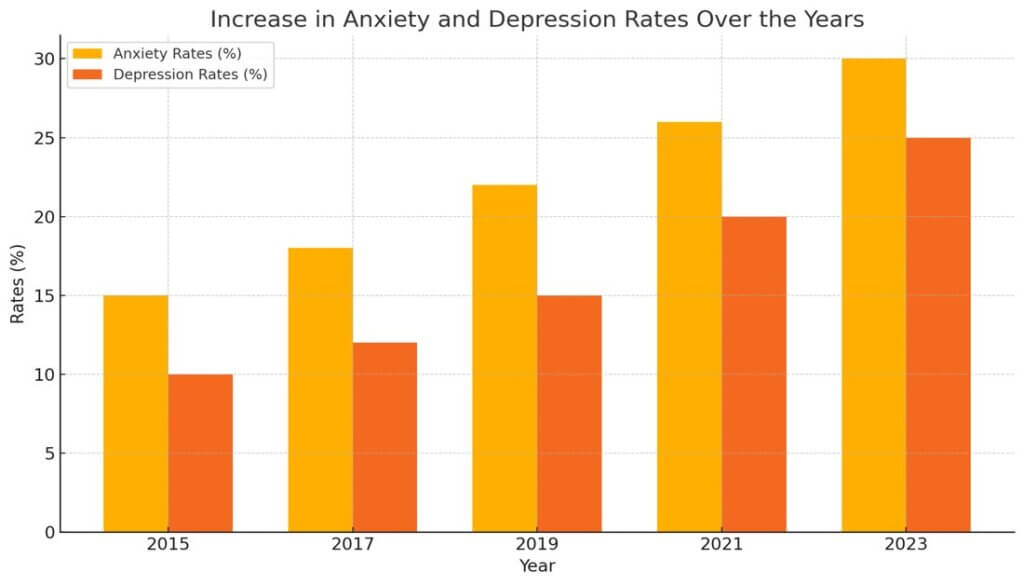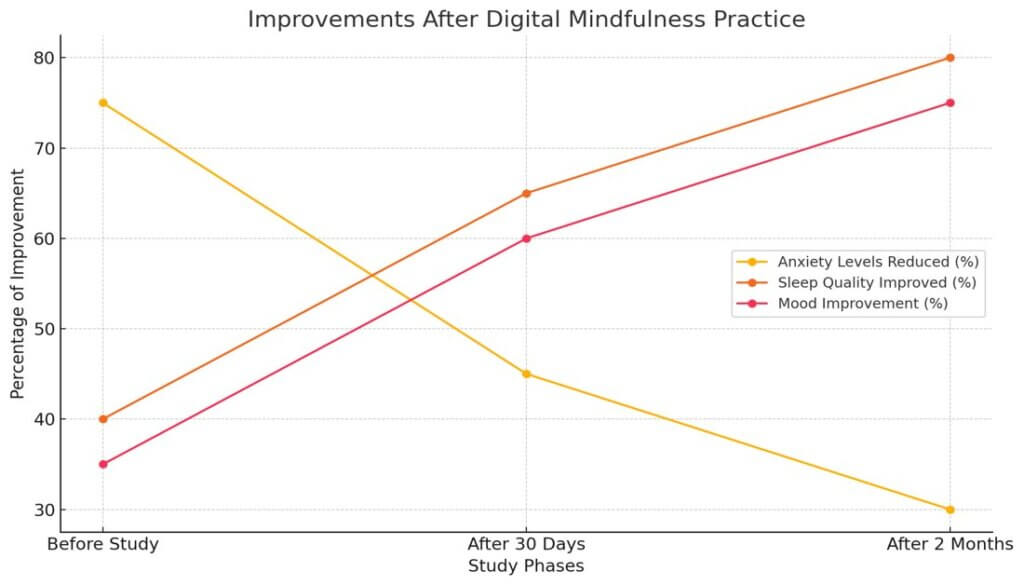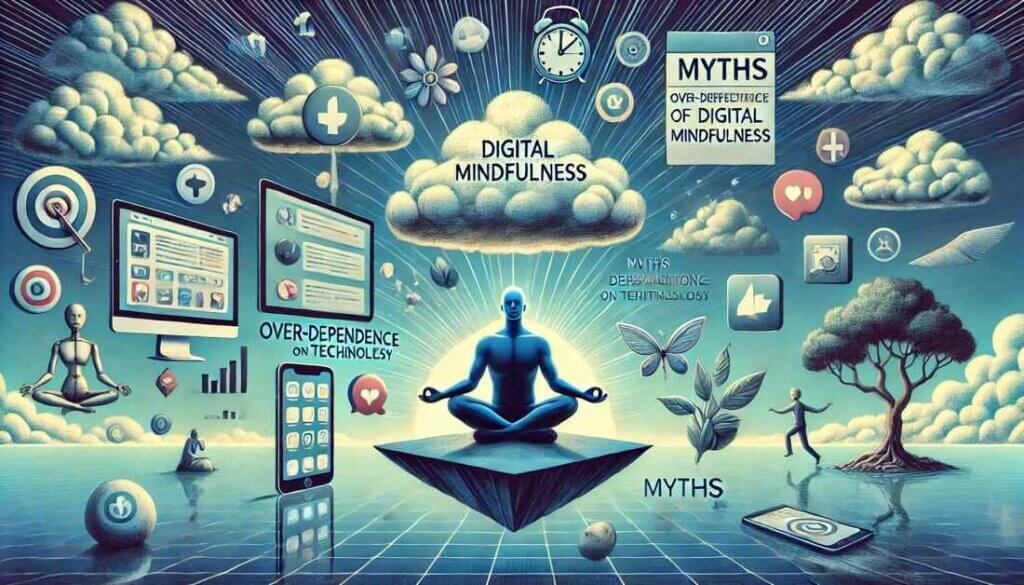Key Takeaways:
1. 1 in 4 people struggle with anxiety: Learn how 10 minutes of daily mindfulness can reduce stress and anxiety, backed by scientific research.
2. Proven Results: Discover how a 30-day study found that digital mindfulness leads to better sleep and less depression.
3. Mindfulness on the Go: Find out how you can practice mindfulness anytime, anywhere, using simple, free apps.
4. Overcome Common Myths: Bust the myth that digital mindfulness is less effective than traditional methods and see how small practices can make a big difference.
5. Small Steps, Big Impact: Start small with beginner-friendly exercises and experience real improvements in your mental wellbeing.
Did you know that nearly 1 in 4 people globally experience anxiety disorders, and over 75% of them go untreated?.
In today’s fast-paced world, it can be difficult to find time to care for your mental health. But what if you could improve your wellbeing in just 10 minutes a day?
Digital mindfulness is a simple, accessible way to do this. This blog will guide you through how digital mindfulness can help boost your mental health and how easy it is to get started.
What is Mindfulness?
Mindfulness is the practice of being fully present in the moment. It means focusing your attention on what you’re doing right now without worrying about the past or the future. It’s about noticing your thoughts, feelings, and surroundings without judgment.
For example, if you’re eating, mindfulness means paying attention to the taste, smell, and texture of the food. You don’t let your mind wander to your to-do list or an argument you had earlier.
Mindfulness helps reduce stress and keeps you grounded. It’s like a mental reset button for your day.
The Importance of Mental Wellbeing

Taking care of your mental health is just as important as taking care of your body. Mental wellbeing affects every aspect of our lives, from how we handle stress to how we communicate with others. When we are mentally healthy, we can think clearly, manage our emotions, and make better decisions.
However, poor mental health can lead to conditions like stress, anxiety, and depression. It also takes a toll on physical health, often leaving us feeling tired, irritable, or even unable to sleep. By focusing on improving our mental wellbeing, we can greatly enhance our quality of life.
As shown in the graph below, mental health issues like anxiety and depression have been steadily rising over the years, especially since the onset of the COVID-19 pandemic. This data highlights the growing need for effective mental health solutions.

The chart shows the alarming increase in anxiety and depression rates globally. From 2015 to 2023, the number of people affected has surged, with anxiety reaching 30% and depression affecting 25% of the population in recent years.
This dramatic rise underscores the importance of finding accessible, daily mental health practices, like digital mindfulness, to help manage these growing challenges.
Just as regular exercise keeps our bodies fit, mindfulness exercises help keep our minds healthy. By incorporating mindfulness into our daily routine, we can reduce stress, improve emotional balance, and combat the growing mental health crisis.
What is Digital Mindfulness?

Digital mindfulness is a modern way to practice mindfulness using apps or online tools. You don’t need to attend a class or spend hours meditating. With digital mindfulness, you can practice for just 10 minutes a day, anytime, anywhere.
Many apps guide you through mindfulness exercises. For example, apps like Medito or Headspace offer guided breathing exercises, body scans, and more. You can practice while waiting for a bus or even during a lunch break.
Digital mindfulness makes it easier to fit mindfulness into your busy life. You can build the habit with very little effort.
The Science Behind Digital Mindfulness

A study conducted by researchers at the Universities of Bath and Southampton proved the effectiveness of digital mindfulness. The study involved over 1,000 adults for 30 days. They were divided into two groups:
- Mindfulness Group: This group practiced mindfulness daily using an app. They did exercises like body scans and breathing exercises.
- Control Group: This group engaged in non-mindfulness activities, like listening to audiobooks.
The study showed that the mindfulness group saw noticeable improvements. They reported less depression, less anxiety, and an overall better sense of wellbeing.
They also made healthier lifestyle choices, such as eating better and exercising more.
Even two months after the study, the benefits continued. The mindfulness group still reported better sleep, reduced anxiety, and healthier habits.
This shows that practicing digital mindfulness for just a few minutes a day can lead to long-lasting improvements.
To better understand the effects, the results can be visualized in the graph below.

The chart highlights the positive changes observed in the mindfulness group over time. Anxiety levels dropped significantly after just 30 days, with a further reduction two months later. Sleep quality showed a steady improvement, helping participants feel more rested.
Similarly, mood enhancements were observed, reflecting a healthier, more positive state of mind. These findings emphasize the long-term benefits of just 10 minutes of daily mindfulness practice.
5 Powerful Ways Digital Mindfulness Boosts Mental Wellbeing
Digital mindfulness offers many benefits. Here are five powerful ways practicing mindfulness for 10 minutes a day can improve your mental health:
1. Improves Mood
Practicing mindfulness helps reduce negative emotions like stress and anxiety. It can make you feel calmer and more positive.
For example, when you focus on your breathing, it shifts your attention away from stressful thoughts. You feel more at ease.
2. Enhances Focus and Concentration
Mindfulness teaches you to focus on one thing at a time. This helps improve your concentration, making you more productive.
For example, practicing mindfulness during a meeting can help you stay fully present, improving your listening and response.
3. Promotes Healthy Habits
Regular mindfulness can motivate you to take better care of yourself. Many people who practice mindfulness are more likely to exercise and eat healthy foods. Mindfulness helps you be more aware of your body’s needs.
4. Improves Sleep Quality
If you struggle to fall asleep, mindfulness might help. Relaxation techniques, like deep breathing, can calm your mind and body, making it easier to sleep. Over time, practicing mindfulness regularly can improve sleep quality.
5. Boosts Emotional Resilience
Mindfulness helps you understand and manage your emotions better. When you practice mindfulness, you become more aware of how you feel. You can manage difficult emotions like anger or sadness more calmly.
Why Digital Mindfulness Works
Digital mindfulness works because it’s simple and accessible. You don’t need any special equipment or skills to get started. All you need is your phone and a quiet place for a few minutes.
The reason digital mindfulness is effective is that it fits into any routine. Whether you’re a student, a working professional, or a busy parent, you can find 10 minutes a day. Apps like Medito or Calm guide you through the process, so you don’t need to figure it out on your own.
Additionally, it’s affordable or even free. You don’t have to spend money on expensive classes or courses. Many apps offer free content or low-cost subscriptions.
Types of Mindfulness Practices

There are many ways to practice mindfulness, and each has its own benefits. Here are five types of mindfulness exercises you can try:
1. Mindful Eating: When you eat, focus on each bite. Notice the flavors, textures, and smells of the food. This practice helps you slow down and enjoy your meals.
2. Body Scan: A body scan involves focusing on different parts of your body, from head to toe. This helps you relax and notice areas of tension.
3. Breathing Exercises: Concentrate on your breathing. Inhale slowly, hold your breath for a moment, and then exhale slowly. This simple exercise helps calm your mind and body.
4. Mindful Movement: Focus on your body’s movements during physical activities like walking or stretching. Pay attention to how your muscles feel as you move.
5. Mindful Listening: Pay close attention to the sounds around you. Whether it’s music, nature sounds, or even silence, notice how it makes you feel.
How to Get Started with Digital Mindfulness
Starting with digital mindfulness is easy. Here’s how to get started:
- Start Small: You don’t need to dive into long sessions. Begin with just 5 or 10 minutes a day. Use free apps like Medito or Headspace to guide you.
- Set a Routine: Make mindfulness part of your daily routine. Set a reminder on your phone to practice every day, whether it’s in the morning or before bed.
- Experiment: Try different mindfulness exercises, such as breathing, body scans, or mindful listening. See what works best for you.
Remember, the goal is consistency, not perfection. As you build the habit, mindfulness will feel more natural.
Challenges of Digital Mindfulness

While digital mindfulness offers many benefits, there are a few challenges that users might face. Here are some common challenges and how to overcome them:
1. Tech Distractions:
Using digital devices for mindfulness can sometimes lead to distractions from notifications or other apps.
To avoid this, put your phone in “Do Not Disturb” mode during your mindfulness session. This way, you can focus entirely on the practice without interruptions.
2. Staying Consistent:
It’s easy to skip mindfulness when you’re busy. To overcome this, set a specific time each day for mindfulness, like right before bed or first thing in the morning. Having a set routine helps make mindfulness a habit.
3. Over-dependence on Technology:
Relying solely on apps or devices for mindfulness may lead to over-dependence, where you feel like you can’t practice without technology.
To counter this, try incorporating mindfulness practices like breathing exercises or body scans without your phone.
Focus on building the skill to practice mindfulness anytime, anywhere, even without a device.
4. Myth About Digital Mindfulness:
A common myth is that digital mindfulness isn’t as effective as traditional mindfulness practices. Some believe that you need to meditate for hours or attend in-person classes to see real benefits.
However, studies have shown that even short sessions of digital mindfulness, like 10 minutes a day, can significantly improve mental wellbeing.
Overcoming this myth starts with understanding that consistency matters more than the medium—whether it’s digital or in-person.
5. Impatience with Progress:
Some users expect instant results from mindfulness. It’s important to remember that mindfulness takes time to show its full benefits.
Start slow, be patient, and track your progress to see the improvements over time. The key is to remain consistent and trust the process.
Conclusion
Friends, I hope you liked my blog post where I talked about the benefits of digital mindfulness. If you enjoyed this blog, I request you to also read my other blog posts.
In them, I have shared more information on various topics related to mindfulness and meditation.
Lastly, I just want to say that in the beginning, you can use these digital tools. But as you gain more experience, you need to slowly reduce your dependence on these tools and become self-reliant.
Otherwise, you might struggle to practice mindfulness without them. So, it’s very important for you to gradually become self-reliant.
To read my other blogs: Click here
Sources:
Anxiety Statistics: World Health Organization
Mental Health Crisis Data: National Institutes of Health